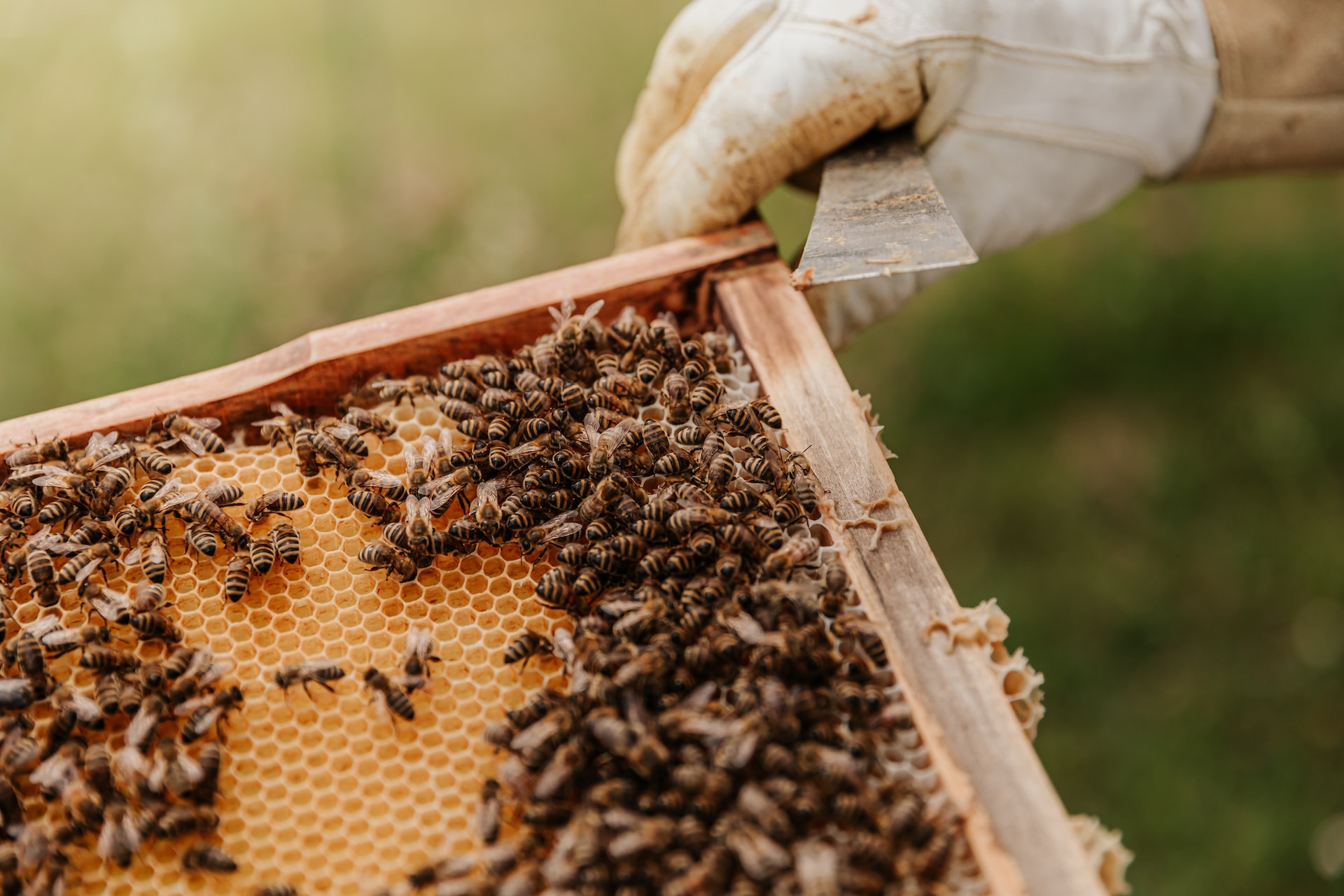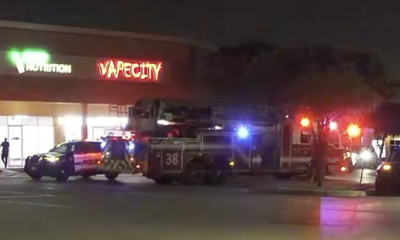Off The Grid
Beekeeping: The Sweet Rewards of Off-The-Grid Living

The morning sun has barely peeked over the horizon, and the air is still crisp with the lingering chill of the night. As I step out into the dawn, a soft hum greets me, a symphony of nature’s hardest workers – the bees. Welcome, folks, to the fascinating world of beekeeping, an essential skill for those embracing an off-the-grid lifestyle.
Beekeeping is more than just a hobby; it’s a lifestyle choice that brings you closer to nature, provides a sustainable source of food, and contributes to the environment. It’s an endeavor that requires patience, knowledge, and a deep respect for these tiny creatures that play a significant role in our ecosystem.
Bees
Honeybees are social insects with a highly organized colony structure. The queen, the drones, and the workers each have their roles to play. Understanding their behavior, lifecycle, and needs is crucial in successful beekeeping. For instance, did you know that during winter, bees huddle around their queen, vibrating to generate heat and keep the colony warm? Fascinating, isn’t it?
Equipment
A sturdy bee suit, gloves, and a veil are non-negotiables for your safety. The hive tool and the smoker are your best friends when it comes to handling the hive. The hive itself can be a traditional Langstroth hive, a top-bar hive, or even a Warre hive. Each has its pros and cons, and the choice depends on your specific needs and the resources at your disposal.
Location
Location is another critical factor. Your hive should be in a place that’s easily accessible, has good sun exposure, and is safe from strong winds and potential flooding. A water source nearby is a bonus, as bees need water for cooling the hive and for their own consumption.
Hive
Starting a hive can be as simple as purchasing a package of bees with a queen, or as adventurous as catching a swarm. Either way, once the bees are introduced into their new home, the real work – and the real joy – begins. Regular hive inspections are necessary to ensure the health of the colony. You’ll need to keep an eye out for signs of disease, parasites, or any other issues that might affect your bees. Remember, a healthy hive is a productive hive.
Honey
And let’s not forget, the sweetest reward of beekeeping – the honey. Harvesting honey is a delicate process that involves uncapping the honey-filled combs and using a centrifuge to extract the honey. But the taste of that first spoonful of golden, sticky sweetness, knowing it’s the fruit of your labor and cooperation with nature, is incomparable.
Pollination
Beekeeping also has an often-overlooked benefit – pollination. Bees are nature’s most efficient pollinators. By keeping bees, you’re not just producing honey, but you’re also contributing to the health of the local flora and, by extension, the entire ecosystem.
Challenges
Now, beekeeping isn’t all sunshine and honey. It comes with its fair share of challenges. Diseases like American Foulbrood or pests like the Varroa mite can wreak havoc on your hives. Harsh weather conditions can pose a threat too. But with vigilance, a willingness to learn, and a deep respect for these incredible creatures, these hurdles can be overcome.
Beekeeping is a journey of understanding and cooperation with nature. It’s about observing, learning, and adapting. It’s a testament to the fact that even in the wildest of wildernesses, we can find a way to not just survive, but to thrive.
If you’re ready to embrace the off-the-grid lifestyle, consider beekeeping. It’s a venture that rewards you with more than just honey. It offers a connection to nature, a sense of accomplishment, and a lesson in resilience and harmony. And trust me, there’s no feeling quite like watching the sun set over your buzzing hives, a jar of fresh honey in your hand, and the knowledge that you’re living life on your own terms, in sync with the rhythm of nature.

Off The Grid
Protecting Vital Documents in Emergencies: A Comprehensive Guide

When the going gets tough, the tough get going. But, my friends, let me tell you, getting going isn’t just about grit and muscle. It’s about preparation. It’s about safeguarding what matters most. And today, we’re going to talk about something that many overlook in their rush to stockpile food, water, and ammo – safeguarding important documents in emergencies.
The first step in protecting your documents is understanding what you need to protect. You’ll need to secure personal identification documents such as passports, social security cards, and birth certificates. These are your proof of identity, and without them, you might find yourself in a bureaucratic nightmare. Financial documents like bank account information, property deeds, and tax records are also crucial. Lastly, don’t forget about medical records and insurance policies. In short, if it’s a document that would be a hassle to replace, it’s worth protecting.
Now, let’s move on to how to protect these vital pieces of paper. The first line of defense is a good old-fashioned safe. Look for one that is fireproof and waterproof. A safe will protect your documents from most natural disasters, but remember, it’s not foolproof. A determined thief or a catastrophic event could still compromise it.
If you’re going to use a safe, make sure it’s secured to the floor or a wall. This way, it can’t be easily removed. And, of course, don’t forget to keep the combination or key in a secure but accessible location.
Next, consider digitizing your documents. This doesn’t mean you should throw away the originals, but having digital copies can be a lifesaver. You can store these on a secure cloud service or keep them on a password-protected external hard drive. Remember, though, that digital storage isn’t infallible. Hackers, viruses, and technical failures can still pose a risk.
For an added layer of protection, consider keeping copies of your most important documents in a secure off-site location, like a safety deposit box at a bank. This way, if your home is compromised, you’ll still have access to your vital records.
Now, let’s talk about portable options. In a crisis situation, you may need to evacuate quickly. That’s when a “grab-and-go” document bag comes into play. This should be a sturdy, waterproof bag that contains copies of your most important documents. Keep it in an easily accessible location so you can grab it at a moment’s notice.
But what about those documents that are too large or unwieldy to store in a safe or a bag? Things like property deeds or vehicle titles? For these, a sealed, waterproof container stored in a secure location can do the trick.
While we’re on the topic of storage, let’s not forget about temperature control. Extreme heat or cold can damage documents, so try to store them in a place with a stable temperature.
Finally, remember to keep your documents organized. In an emergency, you don’t want to be sifting through piles of paper to find what you need. Use folders or envelopes and clearly label everything.
So, there you have it, folks. Safeguarding important documents isn’t the most thrilling aspect of emergency preparedness, but it’s one of the most crucial. It’s about more than just survival; it’s about preserving your identity, your rights, your claims, and your peace of mind. And that, my friends, is worth every bit of effort. Remember, preparation isn’t just a hobby; it’s a way of life. Stay safe, stay prepared, and as always, keep thriving.
Off The Grid
Turning Trash into Treasure: Can You Upcycle Off-the-Grid?

Upcycling is a sustainable practice that involves repurposing discarded materials into useful items, giving them a new lease on life. This eco-friendly approach can be particularly valuable for those who live off the grid or enjoy spending time in the great outdoors. By turning waste into practical tools, you not only reduce your environmental impact but also enhance your self-sufficiency and resourcefulness. In this article, we will explore several upcycling ideas that can help you create valuable off-the-grid tools from seemingly useless items.
One idea is to create a plastic bottle fish trap. Fishing is a popular activity for many outdoor enthusiasts, and a fish trap can help increase your chances of catching dinner. To make a simple fish trap, cut the top off a large plastic bottle and invert it, placing it back into the body of the bottle. Secure the two parts together with duct tape or string, and poke small holes around the bottle for water to flow through. Add some bait, such as bread or worms, and submerge the trap in a water body. The fish will swim in through the inverted opening but will have difficulty finding their way out.
Another idea is to create a tin can lantern. A lantern is an essential tool for any off-the-grid adventure, providing much-needed light during the night. To create a tin can lantern, simply clean an empty tin can and remove the label. Using a hammer and nail, punch a series of holes in a pattern of your choice around the can. Attach a wire handle to the top, and place a candle or tea light inside. The holes will cast a beautiful pattern of light, creating a functional and decorative lantern.
A glass bottle greenhouse is a valuable addition to any off-the-grid homestead, allowing you to extend your growing season and protect your plants from harsh weather. To build a glass bottle greenhouse, collect a large number of glass bottles and remove the labels. Lay a foundation for your greenhouse using bricks or other sturdy materials. Then, start stacking the bottles on their sides, using mortar or clay to hold them together. The glass bottles will create an insulated and light-filled environment, perfect for nurturing your plants.
Composting is an essential practice for sustainable living, turning organic waste into nutrient-rich soil. To create a pallet compost bin, source four wooden pallets and stand them up to create a square enclosure. Secure the corners with screws or metal brackets, and line the inside with chicken wire or mesh to contain the compost. Add your kitchen scraps, yard waste, and other organic materials, turning the pile regularly to speed up the decomposition process.
Cooking is a significant part of off-the-grid living, and having your pots and pans organized and easily accessible is crucial. To create a bicycle wheel pot rack, remove the tire and inner tube from an old bicycle wheel. Hang the wheel from the ceiling using chains or rope, and attach S-hooks around the rim. Hang your pots and pans from the hooks, creating a unique and functional pot rack.
By upcycling waste materials into useful off-the-grid tools, you not only contribute to a more sustainable lifestyle but also develop valuable skills and resourcefulness. These projects are just the beginning; with a little creativity and ingenuity, the possibilities for turning waste into practical tools are endless.
Off The Grid
Off-the-Grid Power: Guide to Harnessing Hand-Crank Devices

Electricity is a crucial part of modern life, powering our homes, gadgets, and appliances. However, access to electricity can be limited or non-existent during emergencies or outdoor adventures. This is where hand-crank devices come in. These portable, manually operated tools generate electricity, allowing you to power your essential devices and equipment when you need it most.
Hand-crank devices work by converting mechanical energy into electrical energy. When you turn the handle, gears inside the device spin a small generator, producing electricity. This simple yet effective technology has been around for decades and is still relevant today, especially for survivalists and outdoor enthusiasts.
There are various types of hand-crank devices available, each designed to serve a specific purpose. Hand-crank flashlights, for example, are an indispensable tool for any survival kit or camping trip. These flashlights generate power through a built-in dynamo, which charges an internal battery or capacitor. A few minutes of cranking can provide hours of light, making them an excellent alternative to traditional battery-powered flashlights.
Hand-crank radios are also essential during emergencies or outdoor adventures. They allow you to stay informed about weather updates, emergency broadcasts, and even provide entertainment. Most hand-crank radios come with AM/FM and NOAA weather bands, ensuring you receive vital information when you need it. Some models also include shortwave bands, allowing you to connect with stations worldwide.
Our smartphones have become an essential part of our lives, providing communication, navigation, and access to vital information. In emergency situations or during outdoor adventures, keeping your phone charged can be a challenge. A hand-crank phone charger can generate enough power to make emergency calls or send messages, ensuring you stay connected when it matters the most.
Hand-crank power banks are versatile devices that can charge multiple gadgets, including smartphones, tablets, and GPS devices. They usually come with built-in batteries that can be charged using the hand-crank, solar panels, or even by plugging into a wall socket. This makes them an excellent addition to your survival kit or camping gear, ensuring you have access to power when you need it.
Clean drinking water is essential for survival, and hand-crank water purifiers can help you achieve that. These devices use a combination of mechanical filtration and UV light to remove contaminants and kill harmful microorganisms, providing you with safe drinking water.
When choosing a hand-crank device, consider factors such as durability, power output, and ease of use. Look for devices made from high-quality materials, as they are more likely to withstand harsh conditions and last longer. Additionally, consider the device’s power output, as this will determine how quickly you can charge your gadgets or how long the device will provide light or radio reception.
Incorporating hand-crank devices into your survival kit or outdoor gear can make a significant difference in emergency situations or when you’re off the grid. These devices provide a reliable and sustainable source of electricity, ensuring you have access to essential power when you need it most. By understanding the various types of hand-crank devices available and selecting the right ones for your needs, you can be better prepared for any situation that may arise.
-

 Tactical12 months ago
Tactical12 months ago70-Year-Old Fends Off Intruder with Lead-Powered Message
-

 Tactical12 months ago
Tactical12 months agoVape Shop Employee Confronts Armed Crooks, Sends Them Running
-

 Preparedness8 months ago
Preparedness8 months agoEx-Ballerina’s Guilty Verdict Sends Tremors Through Gun-Owner Community
-

 Preparedness6 months ago
Preparedness6 months agoGood Samaritan Saves Trooper in Harrowing Interstate Confrontation
-

 Tactical12 months ago
Tactical12 months agoMidnight SUV Theft Interrupted by Armed Homeowner’s Retaliation
-

 Survival Stories1 year ago
Survival Stories1 year agoEmily’s 30-Day Experience of Being Stranded on a Desert Island
-

 Preparedness7 months ago
Preparedness7 months agoArizona Engineer’s Headless Body Found in Desert: Friend Charged
-

 Preparedness7 months ago
Preparedness7 months agoBoy Saves Dad from Bear Attack with One Perfect Shot